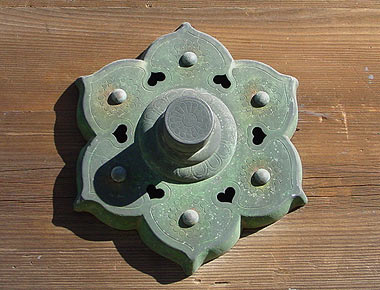| An ornament used to conceal the head of a large
nail on a pressing tie rail *nageshi
長押 and on doors. Made of wood, copper, iron, or gilt bronze. From the Momoyama
period techniques of cloisonne *shippou
七宝, inlay *zougan 象嵌, and
openwork *sukashibori
透彫, decoration were used, and new materials such as ceramics were introduced.
Pre-10c kugikakushi were hemispherical in shape and known as *bai
唄, manjuu kanamono 饅頭金物 (see *manjuugata
饅頭形) or *chichikanamono
乳金物. From about the 10c, kugikakushi were designed using a circle of flower-petal
shapes. The most common types were the four-petalled *shiyou
四葉, six-petalled *rokuyou
六葉, and eight-petalled *hachiyou
八葉. They consisted of a central projection *taru-no-kuchi
樽の口 (cask plug), a round body *kikuza
菊座, and surrounding petal shapes *zagane
座金. |

